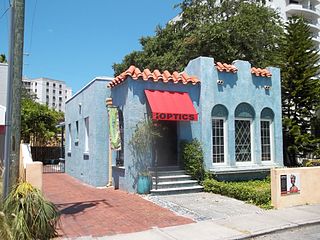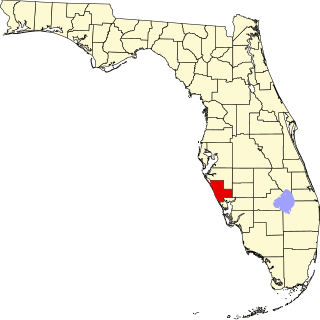
Burns Square Historic District is a historic district located in Sarasota, Florida, United States. The area runs from Ringling Boulevard to Mound Avenue along South Pineapple and South Orange Avenues. Burns Square is bound by Laurel Park Historic District to the east, Palm Avenue residential neighborhood to the west, and Hudson Bayou to the south.

The S. H. Kress and Co. Building at 1442 Main Street in Sarasota, Florida, United States is a historic department store building. It was part of the S. H. Kress & Co. "five and dime" department store chain. On March 22, 1984, it was added to the U.S. National Register of Historic Places.

The Valencia Hotel and Arcade is a historic hotel in Venice, Florida. It is located at 229 West Venice Avenue. On November 10, 1994, it was added to the U.S. National Register of Historic Places.

The Bay Haven School is a historic school in Sarasota, Florida, United States. It is located at 2901 West Tamiami Circle.

The LeClaire Apartments is a historic apartment building in Tampa, Florida, United States. It is located at 3013 through 3015 San Carlos Street. It was designed by Tampa architect Fred J. James. On November 16, 1988, it was added to the U.S. National Register of Historic Places.

The Johnson Schoolcraft Building is a historic site in Venice, Florida. It is located at 201-203 West Venice Avenue. On December 27, 1996, it was added to the U.S. National Register of Historic Places.

The El Vernona Apartments-Broadway Apartments is a historic site in Sarasota, Florida. It is located at 1133 Fourth Street. On March 22, 1984, it was added to the U.S. National Register of Historic Places.

The Frances-Carlton Apartments is a historic site in Sarasota, Florida. It is located at 1221-1227 North Palm Avenue. On March 22, 1984, it was added to the U.S. National Register of Historic Places.

The Roth Cigar Factory is a historic site in Sarasota, Florida located at 30 Mira Mar Court. The building operated as a cigar factory for Edward and Michael Roth from 1923 to 1938. On March 22, 1984, it was added to the U.S. National Register of Historic Places.

The Sarasota Times Building is a historic site in Sarasota, Florida. It is located at 1214–1216 1st Street. On March 22, 1984, it was added to the U.S. National Register of Historic Places. The three-story asymmetrically-massed, stucco and cast stone façade, Mediterranean Revival structure was designed by architect Dwight James Baum. It is significant to Sarasota's heritage for its role as a newspaper established in 1899, and also for its architectural merits.

The South Side School, also known as Southside Elementary School, is a historic school in Sarasota, Florida. It is located at 1901 Webber Street. On September 14, 1984, it was added to the U.S. National Register of Historic Places.

Casa Del Mar is a historic house located at 25 South Washington Drive in Sarasota, Florida.

The El Vernona Hotel–John Ringling Hotel was a famous hotel located at 111 North Tamiami Trail in Sarasota, Florida, United States.

The Rosemary Cemetery is a historic cemetery in Sarasota, Florida. The cemetery is located at the northwest corner of the original plat of the town of Sarasota.

This is a list of the National Register of Historic Places listings in Sarasota County, Florida.

This is a list of the National Register of Historic Places listings in Manatee County, Florida.

Owen Burns was an American entrepreneur, banker, builder, and land developer who at one time owned the majority of the land comprising Sarasota, Florida. He developed or built many of its historic structures, developments, roads, seawalls, and bridges. He became a leader in the community, contributing to its growth and development. He was born in Fredericktown in Cecil County on the Eastern Shore of Maryland.
Dwight James Baum was an American architect most active in New York and in Sarasota, Florida. His work includes Cà d'Zan, the Sarasota Times Building (1925), Sarasota County Courthouse (1926), early residences in Temple Terrace, Florida, Sarasota County Courthouse (1927), Pinecroft, West Side YMCA on 63rd Street between Central Park and Columbus Avenue, Columbus Circle (1934) and Hendricks Memorial Chapel.

The Stevens–Gilchrist House, at 235 Delmar Avenue in Whitfield, Manatee County, Florida, is located in the Whitfield Estates Subdivision in the Sarasota metropolitan area, and was built in 1926. It has also been known as Norrie House. Although the Whitfield Estates Subdivision is in Manatee County, Florida, not in the city of Sarasota, Florida proper, residents use "Sarasota" as their mailing address and have associated themselves more with Sarasota, just to the south, rather than with Bradenton a bit further to the north.






















